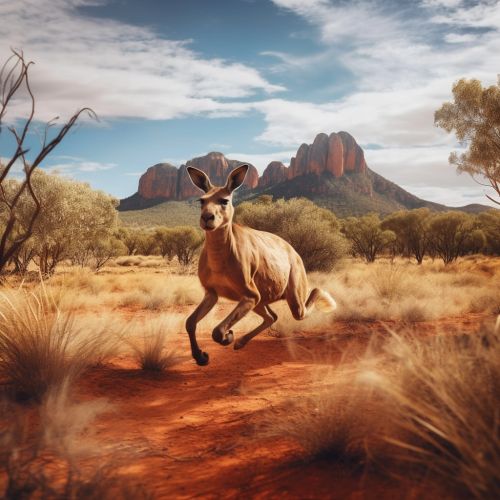Kangaroo
Taxonomy and Evolution
The Kangaroo is a marsupial from the family Macropodidae (macropods, meaning 'large foot'). In common use the term is used to describe the largest species from this family, especially those of the genus Macropus: the red kangaroo, antilopine kangaroo, eastern grey kangaroo, and western grey kangaroo. Kangaroos are indigenous to Australia. The Australian government estimates that 34.3 million kangaroos lived within the commercial harvest areas of Australia in 2011, up from 25.1 million one year earlier.


The evolutionary lineage of kangaroos dates back to the Miocene era, with the modern kangaroo believed to have diverged from its ancestor, the Procoptodon, approximately 15 million years ago. The Procoptodon was a genus of giant short-faced kangaroo, and the largest known kangaroo that ever existed.
Anatomy and Physiology
Kangaroos have large, powerful hind legs, large feet adapted for leaping, a long muscular tail for balance, and a small head. Like most marsupials, female kangaroos have a pouch called a marsupium in which joeys complete postnatal development. The large kangaroo species have adapted much more to the changing climate than smaller macropods, as they have a complex stomach that allows them to ferment their food, similar to the process in the digestive system of a Ruminant.
Behavior and Lifestyle
Kangaroos are the only large animals to use hopping as a means of locomotion. The comfortable hopping speed for a red kangaroo is about 20–25 km/h (12–16 mph), but speeds of up to 70 km/h (43 mph) can be attained over short distances, while it can sustain a speed of 40 km/h (25 mph) for nearly 2 km (1.2 mi). This fast and energy-efficient method of travel has evolved because of the need to travel large distances in search of food and water, rather than the need to escape predators. To move at slow speeds, it uses its tail to form a tripod with its two forelimbs, then raises its hind feet forward. Kangaroos are adept swimmers, and often flee into waterways if threatened by a predator. If pursued into the water, a kangaroo may use its forepaws to hold the predator underwater so as to drown it.
Another aspect of kangaroo behaviour is the complex social structure that they maintain. Kangaroos live and travel in organized groups or "mobs", dominated by the largest male. Male kangaroos are called boomers, bucks or jacks; females are does, flyers, or jills, and the young ones are joeys. The collective noun for kangaroos is a mob, troop, or court.
Reproduction and Development
Kangaroos have a very specialized reproductive system. Female kangaroos have a unique adaptation known as embryonic diapause, which allows them to delay the development of their embryo until environmental conditions are favorable. They have a gestation period of around 33 days, after which the underdeveloped joey makes its way to the mother's pouch for further development. The joey will usually stay in the pouch for about nine months (180–320 days for the Western Grey) before starting to leave the pouch for small periods of time. It is usually fed by its mother until reaching 18 months.
Kangaroos and Humans
The kangaroo is a recognizable symbol of Australia, appearing on the Australian coat of arms, on some of its currency, and is used as a logo for some of Australia's most well-known organizations, such as Qantas. The kangaroo is important to both Australian culture and the national image, and consequently there are numerous popular culture references.
Kangaroos are hunted by licensed shooters in accordance with a strict code of practice and are protected by legislation. Kangaroo meat has perceived health benefits for human consumption compared with traditional meats due to the low level of fat on kangaroos.
Conservation Status
The kangaroo has a wide-ranging impact on its environment. It is a primary consumer that feeds on plants and, in turn, affects soil fertility. Its population dynamics also affect predator populations and ecosystem processes. However, human activity has posed a significant threat to kangaroo populations. The Australian government's wildlife management strategy includes culling, to protect the environment and support farmers. This has drawn criticism from animal rights groups.
